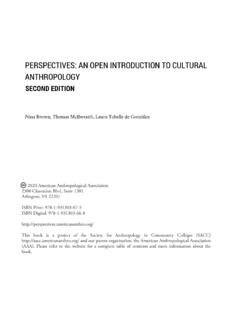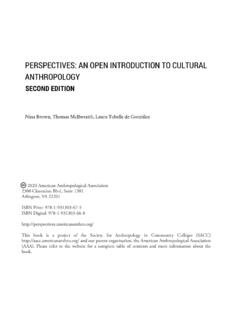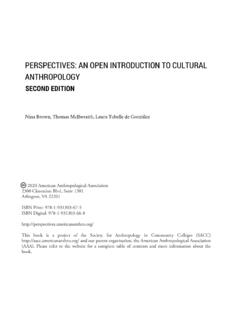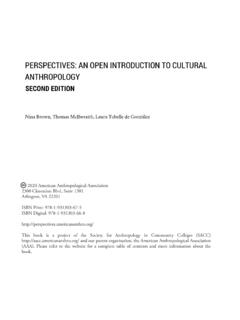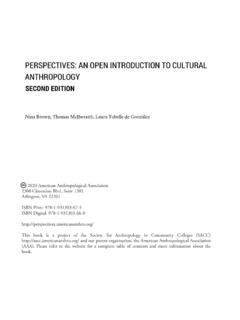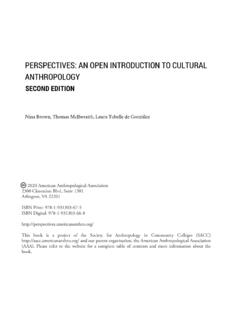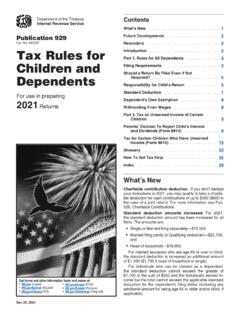Transcription of Perspectives: An Open Introduction to Cultural Anthropology
1 PERSPECTIVES: AN OPEN Introduction TO Cultural Anthropology Nina Brown, Thomas McIlwraith, Laura Tubelle de Gonz lez 2020 American Anthropological Association2300 Clarendon Blvd, Suite 1301 Arlington, VA 22201 ISBN Print: 978-1-931303-67-5 ISBN Digital: 978-1-931303-66-8 book is a project of the Society for Anthropology in Community Colleges (SACC) and our parent organization, the American Anthropological Association (AAA). Please refer to the website for a complete table of contents and more information about the EDITIONP erspectives: An Open Introduction to Cultural Anthropology by Nina Brown, Thomas McIlwraith, Laura Tubelle de Gonz lez is licensed under a Creative Commons Attribution-NonCommercial International License, except where otherwise noted.
2 Under this CC BY-NC copyright license you are free to: Share copy and redistribute the material in any medium or format Adapt remix, transform, and build upon the material Under the following terms: Attribution You must give appropriate credit, provide a link to the license, and indicate if changes were made. You may do so in any reasonable manner, but not in any way that suggests the licensor endorses you or your use. NonCommercial You may not use the material for commercial purposes. 9 9 RACE AND ETHNICITY RACE AND ETHNICITY Justin D. Garc a, Millersville University of Pennsylvania Learning Objectives Learning Objectives Define the term reification and explain how the concept of race has been reified throughout history.
3 Explain why a biological basis for human race categories does not exist. Discuss what anthropologists mean when they say that race is a socially constructed concept and explain how race has been socially constructed in the United States and Brazil. Identify what is meant by racial formation, hypodescent, and the one-drop rule. Describe how ethnicity is different from race, how ethnic groups are different from racial groups, and what is meant by symbolic ethnicity. Summarize the history of immigration to the United States, explaining how different waves of immigrant groups have been per-ceived as racially different and have shifted popular understandings of race.
4 Analyze ways in which the racial and ethnic compositions of professional sports have shifted over time and how those shifts resulted from changing social and Cultural circumstances that drew new groups into sports. Suppose someone asked you the following open-ended questions: How would you define the word race as it applies to groups of human beings? How many human races are there and what are they? For each of the races you identify, what are the important or key criteria that distinguish each group (what characteristics or features are unique to each group that differentiate it from the others)? Discussions about race and racism are often highly emotional and encompass a wide range of emotions, including 204discomfort, fear, defensiveness, anger, and insecurity why is this such an emotional topic in society and why do you think it is so difficult for individuals to discuss race dispassionately?
5 How would you respond to these questions? I pose these thought-provoking questions to students enrolled in my Introduction to Cultural Anthropology course just before we begin the unit on race and ethnicity in a worksheet and ask them to answer each question fully to the best of their ability with-out doing any outside research. At the next class, I assign the students to small groups of five to eight depending on the size of the class and give them a few minutes to share their responses to the questions with one another. We then collectively discuss their responses as a class. Their responses are often very interesting and quite revealing and generate memorable classroom dialogues.
6 DUDE, WHAT ARE YOU?! Ordinarily, students select a college major or minor by carefully considering their personal interests, particular subjects that pique their curiosity, and fields they feel would be a good basis for future pro-fessional careers. Technically, my decision to major in Anthropology and later earn a master s degree and doctorate in Anthropology was mine alone, but I tell my friends and students, only partly as a joke, that my choice of major was made for me to some degree by people I encountered as a child, teenager, and young adult. Since middle school, I had noticed that many people complete strangers, classmates, coworkers, and friends seemed to find my physical appearance confusing or abnormal, often leading them to ask me questions like What are you?
7 And What s your race? Others simply assumed my her-itage as if it was self-evident and easily defined and then interacted with me according to their conclu-sions. 205 Figure 1: The Common Threads mural at Broad and Spring Garden Streets in Philadelphia, PA highlights the Cultural diversity of the city. These subjective determinations varied wildly from person to person and from situa-tion to situation. I distinctly recall, for example, an incident in a souvenir shop at the beach in Ocean City, Maryland, shortly after I gradu-ated from high school. A middle-aged mer-chant attempted to persuade me to purchase a T-shirt that boldly declared 100% Italian.
8 And Proud of It! with bubbled letters thatspelled Italian shaded green, white, and my repeated efforts to convince themerchant that I was not of Italian ethnic her-itage, he refused to believe me. On anotheroccasion during my mid-twenties while I wasstudying for my doctoral degree at TempleUniversity, I was walking down DiamondStreet in North Philadelphia, Pennsylvania,passing through a predominantly AfricanAmerican neighborhood. As I passed a group ofsix male teenagers socializing on the steps of arow house, one of them shouted Hey, honky!What are you doing in this neighborhood? Somewhat startled at being labeled a honky, (something I had never been called before), Ilooked at the group and erupted in laughter,which produced looks of surprise and disbeliefin return.
9 As I proceeded to walk a few moreblocks and reached the predominantly PuertoRican neighborhood of Lower Kensington, three young women flirtatiously addressed me as pap (an affectionate Spanish slang term for man). My transformation from honky to pap in a span of ten minutes spoke volumes about my life history and social experiences and sparked my interest in cul-tural and physical Anthropology . Throughout my life, my physical appearance has provided me with countless unique and memorable experiences that have emphasized the significance of race and ethnicity as socially constructed con-cepts in America and other societies. My fascination with this subject is therefore both personal and professional; a lifetime of questions and assumptions from others regarding my racial and ethnic back-ground have cultivated my interest in these topics.
10 I noticed that my perceived race or ethnicity, much like beauty, rested in the eye of the beholder as individuals in different regions of the country (and outside of the United States) often perceived me as having different specific heritages. For example, as a teenager living in York County, Pennsylvania, senior citizens and middle-aged individuals usually assumed I was white , while younger residents often saw me as Puerto Rican or generically His-panic or Latino. When I lived in Philadelphia, locals mostly assumed I was Italian American, but many Puerto Ricans, Mexicans, and Dominicans, in the City of Brotherly Love often took me for either Puerto Rican or Cuban.

